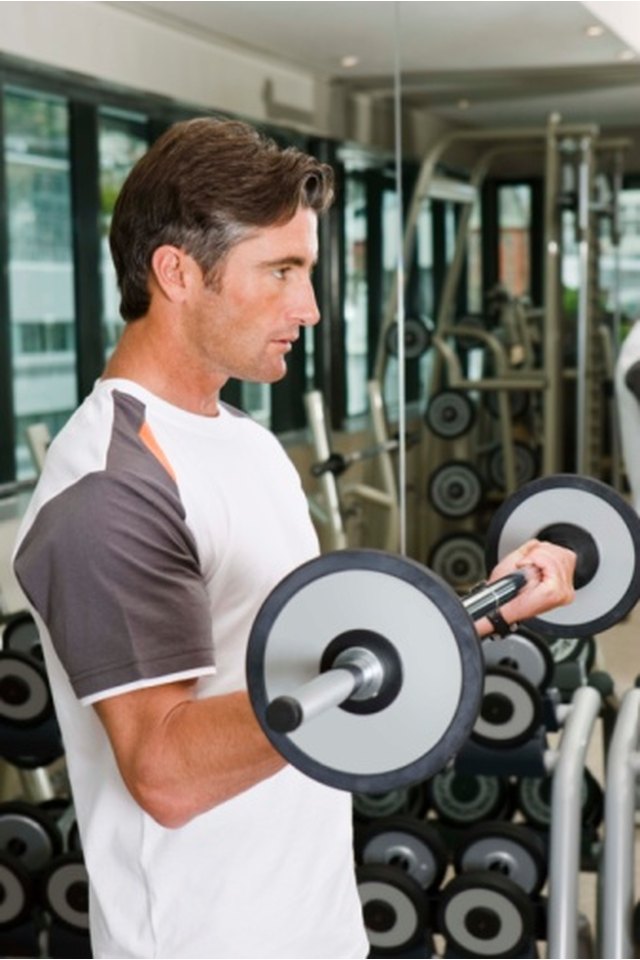What does fact checked mean?
At SportsRec, we strive to deliver objective content that is accurate and up-to-date. Our team periodically reviews articles in order to ensure content quality. The sources cited below consist of evidence from peer-reviewed journals, prominent medical organizations, academic associations, and government data.
The information contained on this site is for informational purposes only, and should not be used as a substitute for the advice of a professional health care provider. Please check with the appropriate physician regarding health questions and concerns. Although we strive to deliver accurate and up-to-date information, no guarantee to that effect is made.
All the Kinds of Exercise Equipment That Work Arms & Legs

Resistance training machines, cable equipment, dumbbells, barbells, medicine balls, aerobic equipment and resistance bands all facilitate exercises that strengthen the arms and legs. The various types of exercise equipment allow you to work your biceps and triceps, as well as your quadriceps, hamstrings, inner thighs and outer thighs in different body positions, and in different planes of motion.
Quadriceps
Your quadriceps, the large muscle in the front of your thigh, straightens your knee joint. The leg extension machine isolates this muscle group. This machine works with you in a seated position, and the exercise begins with your knees bent and your feet under a set of pads. Most of the other types of quadriceps exercise machines, such as the leg press and the squat machine, also work the hamstrings and gluteal muscles. These machines differ from the leg extension in that the foot remains in a fixed position. For the leg press, you place your feet on the foot plate and straighten your legs. The squat, performed in a standing position, places the weight on your shoulders as you perform the exercise. In the cardio room, the upright bicycle emphasizes the quadriceps.
Hamstrings
Your hamstrings, located in the back of your leg, are utilized to bend your knee. The seated leg curl resembles the leg extension, with one significant difference. The exercise begins with your legs extended and your feet on top of the pad. Other hamstring machines include the prone leg curl, performed in a facedown position, and the standing leg curl, which facilitates unilateral hamstring training. Some people prefer to use the lower pulleys and ankle attachments on the cable machine for their hamstrings workout. When no equipment is available, a resistance band around your ankles will suffice, or to blend hamstring with core exercise, perform leg curls from a supine bridge position on a stability ball. Use the recumbent bike for aerobic exercise if you want to target your hamstrings.
Adductors and Abductors
Your adductors or inner thighs move your legs toward the center of your body, whereas the abductors or outer thighs move your legs away from your body's center. The dual-purpose abductor/adductor machine is the most common type of equipment for these muscle groups. Perform both exercises in a seated position with your spine against the back support pad. The abductor exercise begins with your legs together and your knees inside the the knee supports, and the adductor exercise begins with your legs apart, and your knees outside the knee supports. Cable machines and resistance bands also support abductor/adductor exercise. The pilates fitness circle provides isometric abductor/adductor exercise. Place the circle between your legs to work the inner thighs, and outside your legs to work the outer thighs.
Biceps
The biceps, located in the front of your arm, flex your elbow and move your hands toward your shoulders. Machine-based biceps exercises have an elbow support pad and two grip handles, but many serious weightlifters prefer dumbbells for biceps training, because they facilitate increased range of motion and different arm positions. The hammer curl, for example, begins with your thumbs facing directly ahead, and works the lower part of the biceps muscle. Dumbbell training also allows you to alternate arms, which in turn lets you lift heavier weights. Bands, cable machines and chinup bars also support biceps exercises.
Triceps
The triceps sits in the back of your arm and is responsible for straightening your elbow. The triceps machine looks like the biceps curl, but since the exercise involves straightening your arms, the handles are in an upright position at the start of the exercise. Some people complain of elbow pressure when performing machine-based triceps exercise, and prefer the cable machine. The exercise, performed from the upper level cables, uses the double-ended rope attachment. Stand facing the machine, grasping both ends of the rope. Stabilize your elbows as your straighten your arms. The dip machine also provides triceps exercise.
Multi-Functional Equipment
Many cardiovascular machines work the arms and legs simultaneously. A rowing machine, for example, works the hamstrings and quadriceps, while the biceps assist the upper back muscles during the rowing action. Elliptical equipment engages the hamstrings and quadriceps, along with the biceps and triceps. Bicycles with upper body handles work similar muscle groups, but emphasize more quadriceps than hamstrings. Kettlebell and medicine ball programs usually combine arm and leg exercises into functional movement sequences.
References
Writer Bio
In 1999, Lisa Mercer’s fitness, travel and skiing expertise inspired a writing career. Her books include "Open Your Heart with Winter Fitness" and "101 Women's Fitness Tips." Her articles have appeared in "Aspen Magazine," "HerSports," "32 Degrees," "Pregnancy Magazine" and "Wired." Mercer has a Bachelor of Arts in psychology from the City College of New York.
